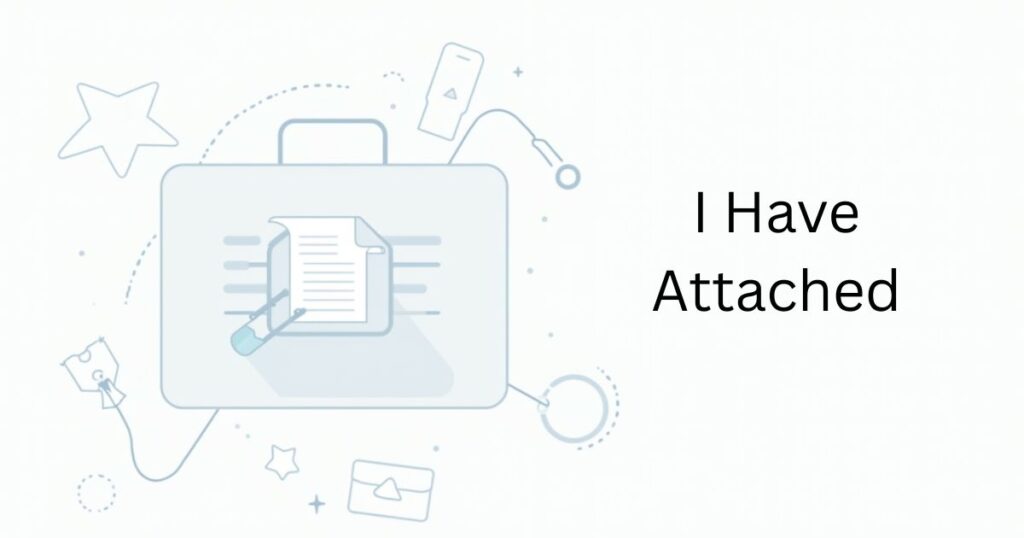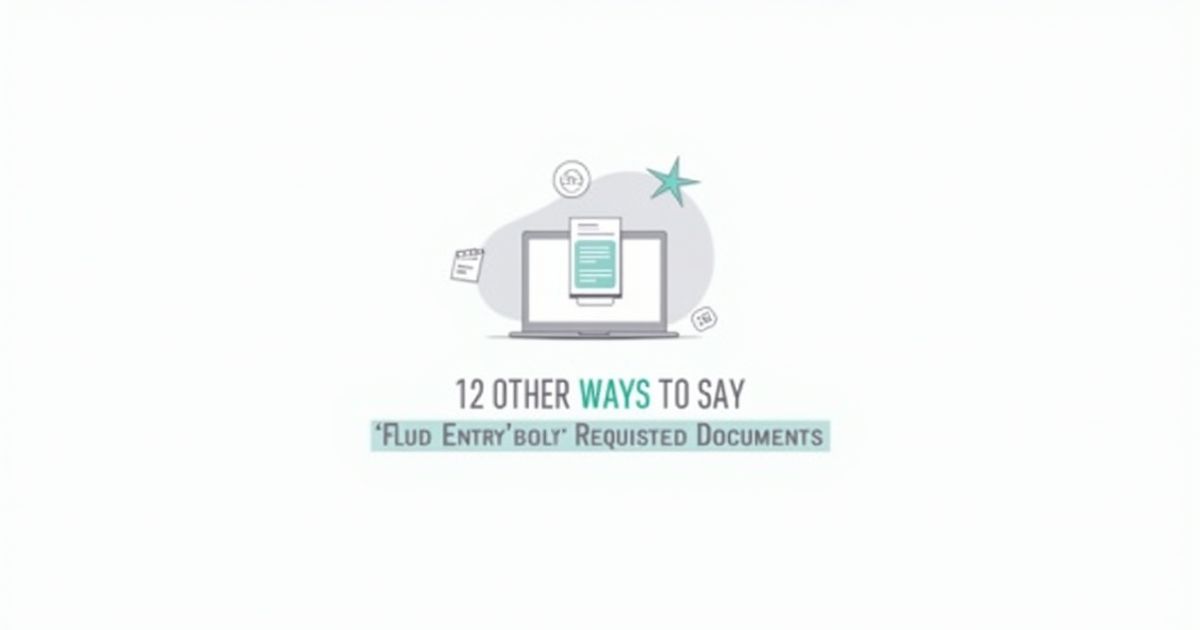You’ve probably typed “Please Find Attached the Requested Documents” more times than you can count. It’s formal, it’s safe, but let’s be honest, it sounds a bit cold. And when used too often, it can make your emails feel stiff or outdated.
This article gives you fresh, human-sounding ways to replace “Please Find Attached the Requested Documents.” Whether you’re writing to your boss, a client, or a teammate, there’s a better phrase for every situation. Some options feel professional, others are more relaxed. You must choose the right tone to fit your message. These small changes show care, build trust, and keep your emails easy to read. So next time, before you copy-paste “Please Find Attached the Requested Documents,” try something better, because the words you choose always matter.
Other Ways to Say “Please Find Attached the Requested Documents”
Using the same phrase repeatedly can make your emails feel robotic. Instead of always writing “Please find attached the requested documents,” switch things up with clearer, friendlier, or more formal alternatives depending on the situation. The right phrase can make your communication more engaging, professional, and easy to understand.
1. Attached Herewith
Example: “Attached herewith are the documents you requested.”
Meaning: This phrase is highly formal and a bit old-fashioned. It’s typically used in legal, academic, or bureaucratic environments where traditional language is expected. “Herewith” means “with this letter” or “in this communication,” making it a direct, formal reference to the attached file.
Usage: Best reserved for legal filings, official reports, or when addressing high-ranking officials in formal business settings. Avoid using it in casual or internal communication, as it can come across as stiff or outdated.
2. Enclosed Please Find
Example: “Enclosed please find the final report for your review.”
Meaning: This phrase also has a formal tone and was historically used in printed letters with enclosures. It’s still acceptable in emails, especially for formal attachments. The word “enclosed” implies that the document is included within the message, not physically mailed.
Usage: Use this in formal business writing, especially when you’re submitting important files like contracts, proposals, or compliance documents. It’s suitable for executive-level correspondence and professional clients who prefer traditional communication.
3. Please See Attached
Example: “Please see attached for the updated agreement.”
Meaning: A modern and common way to refer to attached documents. It’s short, clear, and sounds natural in most business conversations. It avoids sounding robotic or overly stiff while still keeping the tone professional.
Usage: Ideal for everyday work emails, especially when sharing files with coworkers, clients, or vendors. It’s flexible enough for both internal and external communication.
4. The Attached Documents Include
Example: “The attached documents include the revised marketing plan and the competitor analysis.”
Meaning: This version doesn’t just say something is attached, it helps the reader understand what’s inside. By previewing the content, it adds clarity and saves the recipient from guessing.
Usage: Best used when you’re sending multiple files or want to highlight specific items in the attachment. This works well in project communication, meeting follow-ups, or report sharing.
5. I Have Attached

Example: “I have attached the budget sheet for your records.”
Meaning: This is a direct and conversational way to tell someone that you’ve added a file. It makes the sender more visible in the message and sounds more personal than passive alternatives.
Usage: Perfect for internal messages, collaborative emails, or informal client communication. Use this when you’re comfortable with the reader and want to keep things clear and human.
6. Kindly Refer to the Attached
Example: “Kindly refer to the attached schedule for upcoming training sessions.”
Meaning: This is a polite, respectful phrase that gently directs someone to the file. The word “kindly” softens the instruction and adds a courteous touch.
Usage: Suitable for situations where you’re asking someone to look at the file for next steps or important information. Use it in semi-formal to formal emails with partners, clients, or department heads.
7. For Your Reference, I Have Included
Example: “For your reference, I have included last year’s performance reviews.”
Meaning: This phrase lets the recipient know that the attachment is informational. It doesn’t demand action but suggests the material may be helpful to them.
Usage: Ideal when you want to provide background context or supporting material. This works well in collaborative environments, especially when sharing documents that assist with understanding or decision-making.
8. Attached for Your Review
Example: “Attached for your review is the latest version of the employee handbook.”
Meaning: This phrase implies that the file requires attention, feedback, or approval. It shows you’re inviting the recipient to go through the content and possibly respond.
Usage: Use it when submitting drafts, proposals, or anything that might be revised or discussed. It’s great for team collaboration, client feedback loops, and formal review processes.
Read More: 14 Other Ways to Say “Someone Referred Me to You”
9. You Will Find Attached
Example: “You will find attached the completed registration forms.”
Meaning: A formal yet polished way to state that documents are included. It’s indirect but still professional, which can be useful in certain situations.
Usage: Best used in structured, formal communication such as administrative updates, HR notices, or official correspondence. It balances professionalism with a courteous tone.
10. As Requested, Please Find
Example: “As requested, please find the onboarding documents attached.”
Meaning: This expression is great for following up on someone’s specific request. It shows that you’ve acknowledged their need and are responding directly to it.
Usage: Use this when replying to client inquiries, responding to a superior’s task, or fulfilling a file request. It communicates professionalism and attentiveness.
11. Please Refer to the Attached
Example: “Please refer to the attached checklist before your interview.”
Meaning: This is a clear, directive phrase that helps guide the recipient to use the file in a specific way. It often implies that the content is important and should be reviewed carefully.
Usage: Ideal for process-oriented emails, project instructions, or files that the recipient needs to act on. It’s frequently used in operational and HR communication.
12. Enclosed for Your Convenience
Example: “Enclosed for your convenience is the summary of our call notes.”
Meaning: This phrase adds a thoughtful tone, showing that you’re trying to make things easier for the reader. It emphasizes helpfulness and organization.
Usage: Use this when providing extra resources, follow-up summaries, or optional documents that support the main message. It’s suitable for professional but friendly correspondence.
Selecting the Right Alternative Phrases
Choosing the right alternative depends on your audience, purpose, and tone. Use formal phrases for legal or executive emails, and go with simple, clear options for everyday communication. When asking for feedback, use action-oriented wording. Tailor each phrase to match the context, keeping your message professional and effective.
For Formal or Legal Correspondences
In highly formal or legal settings, precision and tone go hand in hand. Phrases like “Attached herewith,” “Enclosed please find,” or “You will find attached” fit well in professional documents where protocol and decorum are essential. These expressions are commonly used in legal filings, official business reports, and government communications. They reflect an adherence to formal business language, which is often expected in these environments.
Using these traditional alternatives signals that you’re aware of professional standards and that you respect the seriousness of the communication. It sets a tone of clarity and professionalism from the outset. Whether you’re sharing contracts, compliance documents, or legal agreements, these phrases ensure the message is received with the appropriate level of formality.
In Everyday Professional Interactions
For typical workplace exchanges, there’s no need to sound overly formal. Phrases such as “Please see attached,” “I have attached,” or “For your reference, I have included” strike a natural balance. They’re clear and professional without sounding rigid, making them perfect for daily emails between coworkers, clients, or external partners.
These alternatives help keep communication efficient and friendly. They’re especially useful when you’re sending reports, proposals, or files during regular workflow. You’re still being professional, but in a way that feels more relatable and less mechanical. These expressions support clarity, encourage responsiveness, and work across departments or industries.
When Soliciting Feedback or Reviews
When you’re sending something that requires a second opinion or approval, it’s important to choose your words wisely. Options like “Attached for your review” or “Please refer to the attached” make it clear that the recipient should engage with the content. These phrases create a gentle but direct invitation to read, comment, or provide input.
They work especially well in collaborative teams or client-facing roles where turnaround and clarity are key. Whether you’re requesting edits to a design draft or feedback on a proposal, these alternatives help set expectations. They show you’re organized, open to input, and moving the project forward with intent.
While Responding to Direct Inquiries or Requests
When someone asks for a document, your response should feel prompt, clear, and professional. Phrases like “As requested, please find” or “Kindly refer to the attached” acknowledge the original request while delivering exactly what was asked. This reinforces that you’re attentive, organized, and responsive.
These phrases also add structure to your communication. They’re especially useful in client interactions, management-level updates, or follow-ups where accuracy and professionalism are key. By referencing the request and delivering the attachment clearly, you leave no room for confusion, and you show reliability in your role.
For Casual or Internal Exchanges
Not every email needs to sound like it’s going to court. In casual or internal exchanges, you can soften the language a bit while staying clear and professional. Expressions like “I have attached” or “Enclosed for your convenience” are friendly and accessible without being too informal.
These phrases make your message feel more relaxed, which is ideal for internal memos, project team updates, or informal notes to coworkers. They show that you’re communicating with ease and clarity, not hiding behind stiff language. This tone can help strengthen team dynamics while still getting things done efficiently.
Conclusion
In emails, using the same phrase again and again can sound boring. “Please Find Attached the Requested Documents” is clear, but not always the best choice. You must use different phrases to sound more natural. This helps your message feel fresh and friendly. You must think about who you’re writing to. Formal or casual? Short or detailed? Choosing the right tone matters.
Try not to always use “Please Find Attached the Requested Documents.” You must pick better words that match your message. Use short phrases that are easy to understand. These small changes show that you care. You sound more professional and thoughtful. You must not confuse your reader. Keep your emails simple and clear. Still, when needed, you can use “Please Find Attached the Requested Documents.” Just don’t rely on it every time. You must improve how you write. Better words lead to better results.

Grammerroot is your trusted source for mastering English grammar and language skills. From simple rules to advanced tips, we help learners build strong foundations through easy-to-understand content. Learn smart, learn right — only at Grammer Root.




